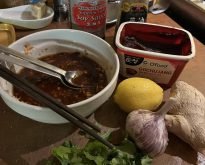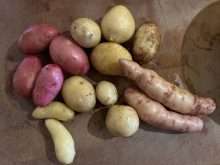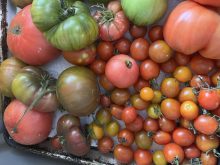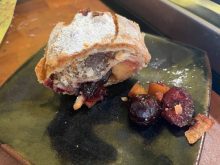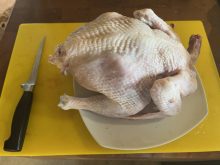Two things happen after I read What We Talk About When We Talk About Dumplings, an essay collection with recipes published by Coach House Books.
First, I take my elderly Momsy to our favourite dim sum palace, where we eat many types of Chinese dumplings. Then I take myself into my kitchen and make some dumplings to share.
We all love dumplings. They show up in wonderful variety around the planet, composed of a filling encased in a dough wrapper of some consistency or other, although the presence of a wrapper is arguable.
Read Also

Maintain motion to ease joint stiffness
As we proceed into colder, drier temperatures, it’s common to hear reports of more joint stiffness and pain, athletic therapist Kathlyn Hossack writes.
Their names also change. My Hutterite grandmother’s Russian-Ukrainian vareniki dumplings, for instance, are similar to Polish pierogi.
In What We Talk About When We Talk About Dumplings, editor John Lorinc describes dumplings in all their varied global glory as “intergenerational time travellers … accompanying us or our ancestors through immigration, exodus, enslavement, commerce, and conquest, like so much culinary-carry-on … [with] nothing as definitive as a recipe … in defiance of our era’s obsession with lovely cookbooks and five-star online recipes.”

The collection’s essays and recipes by an assortment of Canadian literati bear out Lorinc’s assertions.
Among them are existential ravioli by Kristen Arnett and David Buchbinder’s exploration of matzo balls, the wrapper-less dumpling made from unleavened flatbread. Buchbinder insists that because Passover is a celebration of freedom, the matzo ball integral to the accompanying Seder meal should be light and fluffy, best in soup redolent of herbs, fat and long-simmered bone broth.
Trinidadian-born Giller-Prize-winning novelist André Alexis recalls his childhood dumplings made of flour and cornmeal, “solid, glutinous and toothsome … somewhere between solid and airy, the culinary equivalent of a colloid,” like himself as an immigrant, neither of here nor of there, “half this, half that.”
Julie van Rosendaal composes an ode to perogy bees as “the social media of generations past,” and Miles Morrisseau muses on his Metis mother’s duck dumpling soup.
Lorinc recalls the trials of mastering szilvás gombóc, or Hungarian plum dumplings, with his sister and his son after his mother could no longer make the traditional autumn dish.
In Eric Geringas’s 1990 trip to Prague after the fall of the Iron Curtain, he meets a bread dumpling called knedlik. While there, he falls in love with Czech “black humour, the winking anti-authoritarianism … a culture of survival, of learning to thrive even when power is in someone else’s hands.” The ubiquitous knedlik serves as a “middle finger to pomposity,” just as dumplings made of humble ingredients are everyday food around the world.
Sylvia Putz’s essay puts me in the centre of a Korean dumpling-making party of women, and it’s time to cook. A dumpling by any other name. First we eat, then we argue taxonomy.

Potstickers
This potsticker filling is good in half-moon jiaozi and open-top siu mai. They’re usually served steamed, but I fry and then steam them for crispy flat bottoms. Makes about 80.
- 1 large bunch chard
- 1 onion, finely minced
- 1 large carrot, grated
- 1 head garlic, minced
- 1/4 cup grated ginger root
- 2 pounds ground raw turkey, chicken, pork or a blend
- 1 pound chopped raw shrimp
- 1/4 cup each minced cilantro, chives, spearmint and basil
- 1/4 cup soy sauce
- 1/4 cup fish sauce
- Hot chili paste to taste
- 2 eggs
- 2 packages won ton wrappers
- Oil for sautéing
Serve with this vinegar-chili dip:
- 1/2 cup black or rice vinegar
- 1/2 cup soy sauce
- 1/2 teaspoon roasted sesame oil
Cut off the chard stalks, mince them and steam in a large shallow pan. Chop the chard leaves and add. When wilted, remove from heat, drain and pat dry.
Combine remaining ingredients with the chard, excluding the won ton wrappers and oil. Mix thoroughly.
Trim corners off square wonton wrappers to make them round. Cover stack of wrappers with plastic to keep them from drying out. (Fry corner trimmings for a terrific salad garnish!)
Put one wrapper on the palm of your hand and add a spoonful of filling. Fold wrapper up from bottom to cover filling and create a short cylinder with an exposed top. Place on a tray dusted with cornstarch. Repeat. Freeze in a single layer, and transfer into freezer bags once solid.
To cook, remove potstickers from freezer and heat a sauté pan on moderately high heat. Add enough oil to lubricate pan. Add potstickers in a single layer. Sauté until well browned (check by picking up one and inspecting the underside).
Add a half-inch of water. Cover snugly and cook until water evaporates and the dumplings are cooked through, about seven minutes. Immediately use a metal spatula to free potstickers from pan before they stick. Clean pan before cooking next batch.
Combine in several individual ramekins.



